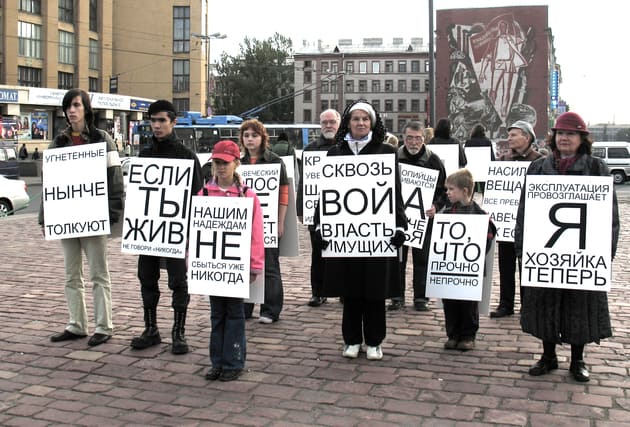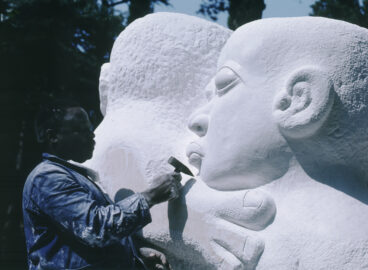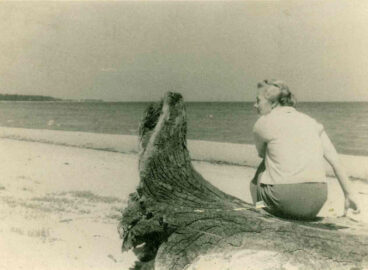A major publication, Art and Theory of Post-1989 Central and Eastern Europe: A Critical Anthology, presents key voices of this period that have been reevaluating the significance of the socialist legacy, making it an indispensable read on modern and contemporary art and theory. The publication offers a rich collection of texts and an additional, reexamining perspective to its 2002 sister publication, A Sourcebook for Eastern and Central European Art since the 1950s, part of MoMA Primary Documents publications. For this book, a series of conversations were commissioned with artists in the region and members of the C-MAP research group for Central and Eastern Europe at MoMA. The following is an interview conducted by the third editor of the book, Ksenia Nouril, and Dmitry Vilensky of Chto Delat.

Ksenia Nouril: With the rapid encroachment of right-wing politics across Europe and in the U.S., it can be said that the left is in crisis. In the past, you proposed a solution by “politicizing the cultural field” through mobilizing forms of collective self- organization, such as art soviets or councils that practice—not only espouse—leftist ideals. Could you describe the challenges in adopting and translating these organizational models into art? What is the relationship between art and politics, art and activism, according to Chto Delat, the collective you helped found in 2003?
Dmitry Vilensky: We never had big illusions about “real leftist” politics. As Alain Badiou said on the day after the 2016 U.S. presidential election, politics has completely lost any idea of true alternatives. We can easily project this onto the art world where we definitely see more and more Clinton-like figures with rather hypocritical approaches toward politics.
The question of what art can do in the absence of true emancipatory politics is very urgent. How can the notorious autonomy of art function to forecast the project of emancipation and equality? I think we—artists and the art world—should provide fewer services aimed at improving the existing disorder of the neoliberal world, leaving that to the vast number of proper NGOs with serious budgets and structures, and instead focus our energies on forming and addressing not-yet-existing communities.
Again in the same speech, Badiou said, “Bernie Sanders was on the side of rational, active, and clear popular subjectivity, oriented beyond the world as it is, even in something which was unclear—unclear, but beyond the world as it is,” and this is precisely what art can and must do.1Alain Badiou, “Reflections on the Recent Election,” Verso Books blog post, November 15, 2016: http://www.versobooks.com/blogs/2940-alain-badiou-reflections-on-the-recent-election. Chto Delat, as a collective, tries to do our best not just to imagine these not-yet-existing communities but also to make them happen in reality. The task is how to find a dialectical balance between autonomy and engagement.
It is interesting to note that we in Russia have a certain “advantage” because we already live in a situation in which “a field called the liberal arts, including contemporary art in all its guises—in its collected, if not collective, articulations” is under threat, as cited by Simon Sheikh.2Simon Sheikh, “Art after Trump,” e-flux conversations blog post, November 2, 2016: http://conversations.e- flux.com/t/simon-sheikh-art-after-trump/5325. We have been trying to learn how to exist in this situation for more than decade and are forever asking ourselves who we are and what we represent.
The answer, which Sheikh offers us, sounds pretty close to describing our marginal position and aesthetic program, which we have been pursuing for a long time: “I do not want to suggest, however, any return to the historical avant-gardes and their resistance to fascism, as fascism today takes other forms, and art must thus also take other forms. It is not really a matter of art becoming propaganda and protest, although I am sure that much great cultural production will now be made in this vein, in opposition. I am, rather, thinking of the arts as a field, of how we will mobilize and find solidarity as art workers in a system that is already undemocratic, and in a democracy under siege.”
KN: History—namely, the histories of the former Soviet Union and of international leftist movements—is a major theme in your practice, specifically in works like theSongspiel Triptych (2008–10). Why is it still important for you and for us to think through the history of the Soviet Union more than twenty-five years after its dissolution?
DV: We are very critical towards the history of the Soviet Union, but we always consider the lost chances for true emancipation during this period of history, which need to be discovered and actualized. Today, when fewer and fewer people are able to remember anything, this fight over historical memory comes to the fore. Those who keep fidelity to past events, thus creating possible preconditions for a new one, must reclaim the potential for true emancipatory politics. It would be interesting to reflect on the proletariat—the subject of past emancipations—who now appear lifeless, and their “resurrection,” which is very similar to the idea of zombie politics, and to speculate on how the zombie condition allows us to reveal and approach the current state of the world.
KN: Self-education has been a central tenant of Chto Delat’s work. You established the School of Engaged Art in St. Petersburg in 2013. Seeing this school within a tradition of alternative education, how do you define “engaged art”? How do you relate your contemporary concept of “engaged art” to the historical avant-garde idea of merging art and everyday life?
DV: We believe in not only establishing links to the ideas of historical avant-gardes but also in testing how they might function in a completely new political, economic, and social situation. We are sincere in our understanding of engaged art as a certain form of negation, because it is about breaking with society as it stands today. But engaging means also affirming, because it affirms the constituency of nonexisting people and works to materialize them. This type of engagement calls on society to transform, and we envision this transformation as a struggle for equality, peace, solidarity, and unity. We speak inside the context of a very repressive, exclusionary, xeno-, homo-, and transphobic society, in which basic ideas of economic, gender, and ethnic equality are under threat. How can a marginal community challenge the consensus of the majority? We believe this can be achieved only by demonstrating a vivid example of how society can function otherwise, and why the example should become commonplace. These ideas reflect a complex dynamic of relations between exodus and participation—the exodus creates autonomous spaces that have the possibility to grow and influence society, and to facilitate this growth, they need to accumulate and instrumentalize all possible resources that do not compromise their autonomy. Only by keeping a clear-cut agenda can we gain power to resist the acceleration of the deconstruction of the commons. But why do we keep talking about art? Art is considered something irrelevant, corrupted, and bourgeois—NO!
We need to advocate for a certain belief in art’s power that, despite all traps, still keeps its promise of transformation of humanity and radical equality for all, dead and alive.
Yes – to collective practice
Yes – to autonomy
Yes – to dignity
Yes – to militancy
Yes – to unity in differences
Yes – to respect and solidarity
Yes – to equality in inequality
Yes – to the commons
Yes – to dialectics YES to the arts!
KN: With regard to the centennial of the Russian Revolution in 2017, you have suggested, “There are certain material traces—places and knowledge—which are better accessible through field research.” What would you say is the meaning of the historical Russian Revolution in Putin’s Russia today? I am wondering if you (as an artist, activist, or artist-activist) think something can be done and, if so, what?
DV: Yes, we believe that there are certain material traces of the Russian Revolution that are best accessed through field research, which we practice with our students in the School of Engaged Art, which is open to both Russian and international practitioners.
I am not sure if we will survive until the next radical change that is any true revolution. But that does not mean that, now, until that time, we must obey the current status quo and stop dreaming, working, and challenging the existing order. The moment of the centennial of the Russian Revolution is a good time for us to resist the official version of this event—the reconciliation between all living and dead political forces under a neoconservative, quasi-monarchist power. In this situation one can deliver one simple message: we must not reconcile with these rules, but we must remind people that a revolution has happened and could happen again. The true meaning of revolution must live within us.
KN: You’ve characterized your work as “push[ing] forward a debate about what can be art and what art is.” You’ve also been critical of the political formalism of certain contemporary Russian artists. Could you describe some of the aesthetic devices Chto Delat uses in its work, and how do you see these advancing your strategies as socially and politically conscious activist-artists?
DV: I, speaking as an individual, and we, speaking for the collective, are rather skeptical about some forms of hermetic political minimalism or abstraction that are major trends in contemporary art in Russia and internationally. We trace our genealogy more to a realist tradition, combined with surrealist and absurdist elements. We have as our motto the rather famous expression by Bertolt Brecht: “educate, entertain, inspire.” We really hope that our works address people who do not have special training in understanding contemporary art. We want to be popular among a wide audience outside the contemporary art world; thus, we are trying to challenge the consensus that prevails in art institutions, which mostly address privileged audiences (or try to reach unprivileged ones but often in a rather irresponsible and hypocritical way). This is not easy because access to the arts is under the control of major institutions, themselves under the influence of corporate sponsors, who are hardly in any position to change this situation.
At the same time, our approach is far from reductivist. We try to construct our works as multilayered formal narratives that can be read differently by different audiences but still maintain a principle of openness to everyone. In our dramatic and tragic situation today, we need to create works that are for the people and with the people. This is a very complex task, but we cannot ignore it anymore. This is the root of any contemporary tragedy, which is our favorite medium. We need to be challenged and to demonstrate the play of irreconcilable forces and fate and not pretend that everything can stay nice forever before it ends. We hope that dialectics start to play a role so things can one day be changed, and people can start to truly believe that together we hold the future in our hands.
- 1Alain Badiou, “Reflections on the Recent Election,” Verso Books blog post, November 15, 2016: http://www.versobooks.com/blogs/2940-alain-badiou-reflections-on-the-recent-election.
- 2Simon Sheikh, “Art after Trump,” e-flux conversations blog post, November 2, 2016: http://conversations.e- flux.com/t/simon-sheikh-art-after-trump/5325.


